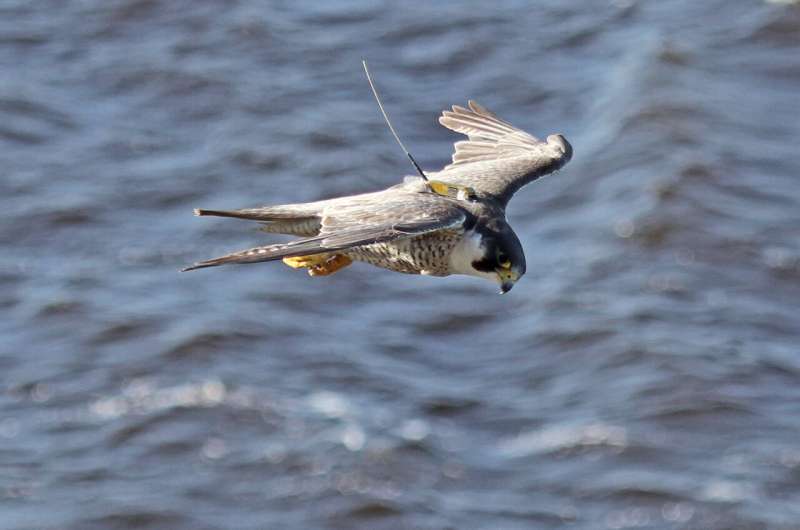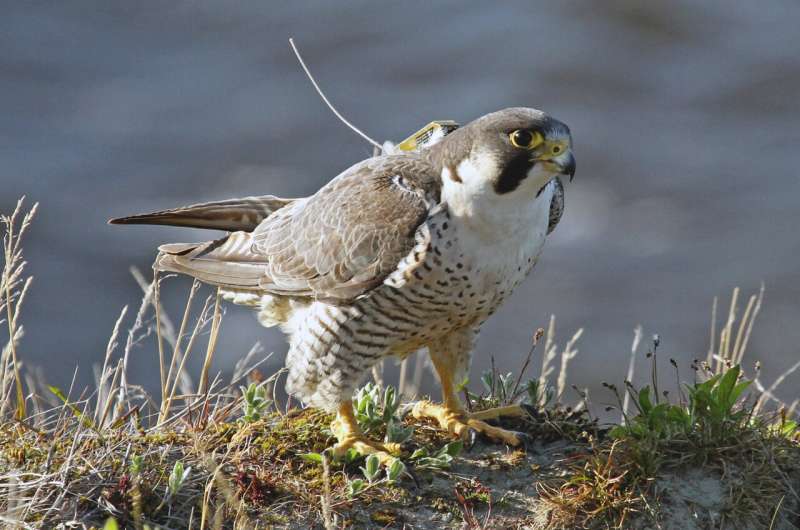Scientists find strongest evidence yet of 'migration gene'

A team from the Chinese Academy of Sciences and Cardiff University say they have found the strongest evidence yet of a "migration gene" in birds.
The team identified a single gene associated with migration in peregrine falcons by tracking them via satellite technology and combining this with genome sequencing.
They say their findings add further evidence to suggest genetics has a strong role to play in the distance of migration routes.
The study, published today in the journal Nature, also looks at the predicted effect of climate change on migration—and how this might interact with evolutionary factors.
The researchers tagged 56 Arctic peregrine falcons and tracked their journeys by satellite, following their annual flight distances and directions in detail.
They found the studied peregrines used five migration routes across Eurasia, probably established between the last ice age 22,000 years ago and the middle-Holocene 6,000 years ago.
The team used whole genome sequencing and found a gene—ADCY8, which is known to be involved in long-term memory in other animals—associated with differences in migratory distance.
They found ADCY8 had a variant at high frequency in long-distance (eastern) migrant populations of peregrines, indicating this variant is being preferentially selected because it may increase powers of long-term memory thought to be essential for long-distance migration.

One of the authors on the study, Professor Mike Bruford, a molecular ecologist from Cardiff University's School of Biosciences, said: "Previous studies have identified several candidate genomic regions that may regulate migration—but our work is the strongest demonstration of a specific gene associated with migratory behaviour yet identified."
The researchers also looked at simulations of likely future migration behaviour to predict the impact of global warming.
If the climate warms at the same rate it has in recent decades, they predict peregrine populations in western Eurasia have the highest probability of population decline and may stop migrating altogether.
"In this study we were able to combine animal movement and genomic data to identify that climate change has a major role in the formation and maintenance of migration patterns of peregrines," said Professor Bruford.
Professor Xiangjiang Zhan, honorary visiting professor at Cardiff University, now based at the Chinese Academy of Sciences, said: "Our work is the first to begin to understand the way ecological and evolutionary factors may interact in migratory birds—and we hope it will serve as a cornerstone to help conserve migratory species in the world."
The work was carried out by a joint laboratory for biocomplexity research established in 2015 between Cardiff University and the Institute of Zoology at the Chinese Academy of Sciences in Beijing.
More information: Climate-driven flyway changes and memory-based long-distance migration, Nature (2021). DOI: 10.1038/s41586-021-03265-0 , dx.doi.org/10.1038/s41586-021-03265-0
Journal information: Nature
Provided by Cardiff University





















